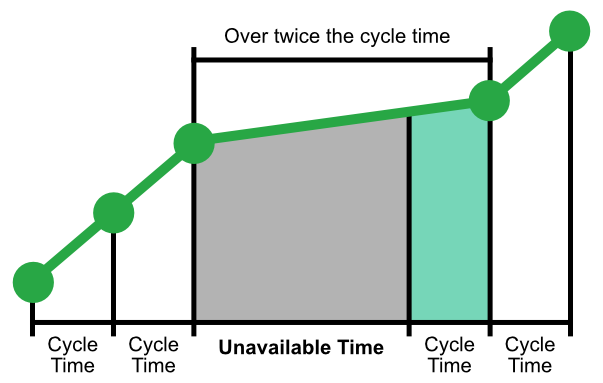Part of the OnTakt User Guide.
What is OEE?
OEE (Overall Equipment Effectiveness) is a standard for measuring manufacturing productivity.
For more information, visit the OEE website.
Wolfram Manufacturing does not endorse OEE as an accurate measurement of manufacturing productivity.
OEE in OnTakt
With OnTakt Server 2.3.12 and newer, OEE must be manually enabled in Machine settings → Advanced → Use OEE. Older versions always have OEE enabled.
How OnTakt calculates OEE
OEE is the product of three components, each scored as a percentage. This means that a zero for any component score will result in a 0% overall score, and components that score 100% do not affect the overall score.
For example, if the component scores are 50%, 100%, and 75%, the overall score is 0.5 × 1 × 0.75, which is 0.375 or 37.5%.
Component scores that are reported as N/A do not affect the overall score. If all component scores are reported as N/A, the overall score will also be reported as N/A.
1. Availability
Availability is the ratio of "unavailable time" to the total length of the shift. Unavailable time is the sum of all times in a day when a machine takes longer than twice the expected cycle time to produce a part, as shown below:
For example, an availability of 100% means the machine did not stop producing parts for a significant amount of time all day, and an availability of 50% means the machine spent half of the shift not running.
The availability score only counts parts from programs with a cycle time specified.
If shift times are not set, the availability score may be reported as N/A.
OnTakt server version 4.10.25 and newer: if there are any downtime blocks reported for the current day, their total duration will be used as the "unavailable time" instead.
2. Performance
Performance is the ratio of expected cycle time to actual cycle time, averaged for all parts in a day.
For example, assume a part has a cycle time of 60 minutes. If it takes 20 minutes to produce, the performance score for that part would be 300%. On the other hand, if it takes 120 minutes to produce, its performance score would be 50%. If a machine did both of these in the same day, the total performance score would be averaged to 175%, which would be capped at 100%.
The performance score only counts parts from programs with a cycle time specified.
If no such parts have been produced, the performance score will be reported as N/A.
3. Quality
Quality is simply the ratio of good to scrapped parts.
For example, if a machine has produced 10 total parts in a day, 2 of which were scrapped, the machine's quality score would be 80% for the day because 8 of 10 parts were good.
If no parts have been produced, the quality score will be reported as N/A.
